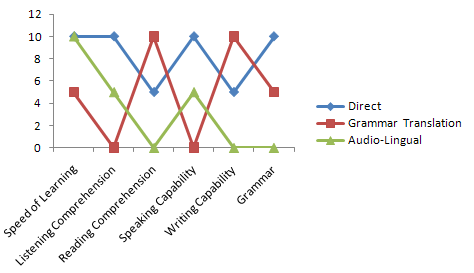There are three teaching methods that dominate the business of language instruction: the Direct Method, the Grammar-Translation Method, and the Audio-Lingual Method. Deciding which is the best method is difficult because each has strengths and weaknesses, and the nature of a student’s goals will determine which is best for that student. Although many language-training sources may speak about exclusive or unique approaches, with few exceptions, they are using one of these three methods. We conducted extensive research on the subject of teaching methods for our online language training programs. Here is a description of the three primary language teaching methods, along with our analysis of the strengths and weaknesses of each one:
The Direct Method
The Direct Method is also known as the Oral or Natural method. It’s based on the active involvement of the student in both speaking and listening to the new language in realistic everyday situations. The process consists of the gradual acquisition of grammatical structure and vocabulary. The learner is encouraged to think in the target language rather than translate. He or she hears and uses the language before seeing it written.
The Grammar-Translation Method
This method grew from the traditional method of teaching Latin and Greek. The method is based on analysis of the written language using translation exercises, reading comprehension and written imitation of texts. Learning mainly involves the mastery of grammatical rules and memorization of vocabulary lists.
The Audio-Lingual Method
This self-teaching method is also known as the Aural-Oral method. The learning is based on the repetition of dialogues and phrases about everyday situations. These phrases are imitated, repeated, and drilled to make the response automatic. Reading and writing are both reinforcements of what the learner practices.
Comparing the Language Training Methods
This comparison graph shows the expected results for a typical student applying the same amount of time and motivation to learning. We scored the value of each method from 1 to 10 in the following aspects: Speed of Learning, Listening Comprehension, Speaking Capability, Writing Capability, and Grammar.
The Direct Method gives the student the ability to communicate quickly because she is encouraged to be creative during practice. It gives, by far, the widest range of capability to understand what another person says to you and in developing your capability to speak. This is the method of choice for instruction with a live trainer and where speaking and listening are most important.
The Grammar-Translation method requires the learner to spend a lot of time understanding the language structure. Listening and speaking suffer because of this. Understanding the structure is helpful in reading and particularly in writing. Grammar and vocabulary are emphasized throughout. This is the method of choice when the student’s goal is to achieve a high level of writing and reading ability in a foreign language versus speaking and listening.
The Audio-Lingual Method also allows the learner to communicate quickly but within the limited range that the repetition allows. It improves comprehension only if the speaker uses phrases that the learner has studied. Reading is limited, and an understanding of how to use the language is very limited. This is the method that is used when a live trainer is not available.
____________________________________________________________________________________________
ALTA creates customized online language training programs based on the Direct Method and the Audio-Lingual Method. ALTA trainer-led programs include placement tests, progress tests, and achievement tests to verify language skills improvement. The Audio-Lingual Method is used for specialized programs that are not trainer-led, particularly at the lower levels of initial skill.

